An In-Depth Analysis of Credit Risk Management Strategies
VerifiedAdded on 2020/04/15
|13
|3184
|58
Essay
AI Summary
The essay offers a detailed exploration of the key elements involved in effective credit risk management. Highlighting the necessity of an efficient loan review system and diversification strategies, it discusses how these approaches mitigate risks associated with lending practices. The paper also stresses the importance of establishing clear collateral guidelines, appointing competent credit officers, and regularly reviewing financial documents such as business revenue statements and cash flow reports. By examining these components, the essay aims to provide a comprehensive understanding of how institutions can enhance their credit risk management frameworks to support stable financing environments for both small and medium enterprises (SMEs) and franchisee-franchisor relationships.
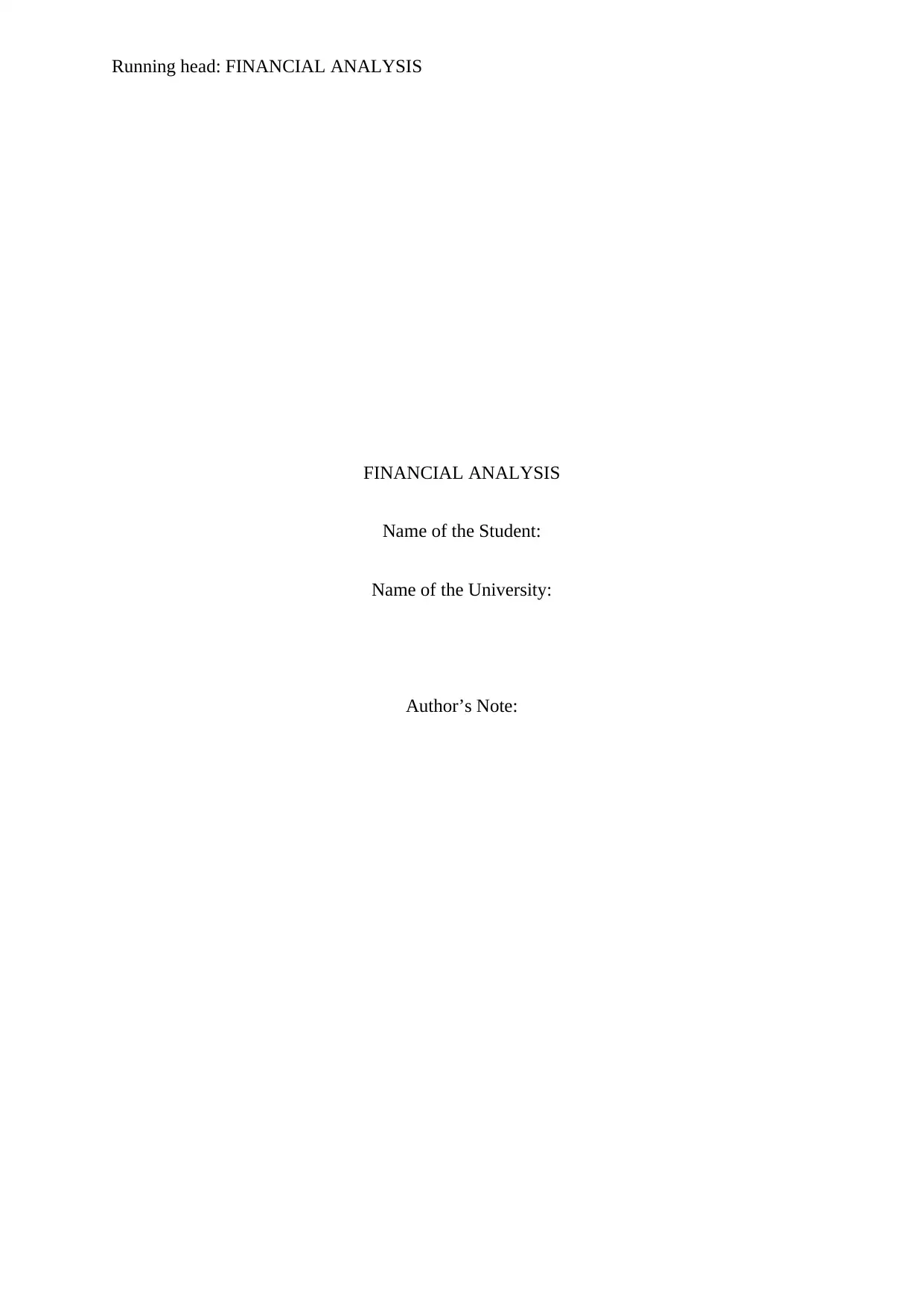
Running head: FINANCIAL ANALYSIS
FINANCIAL ANALYSIS
Name of the Student:
Name of the University:
Author’s Note:
FINANCIAL ANALYSIS
Name of the Student:
Name of the University:
Author’s Note:
Paraphrase This Document
Need a fresh take? Get an instant paraphrase of this document with our AI Paraphraser
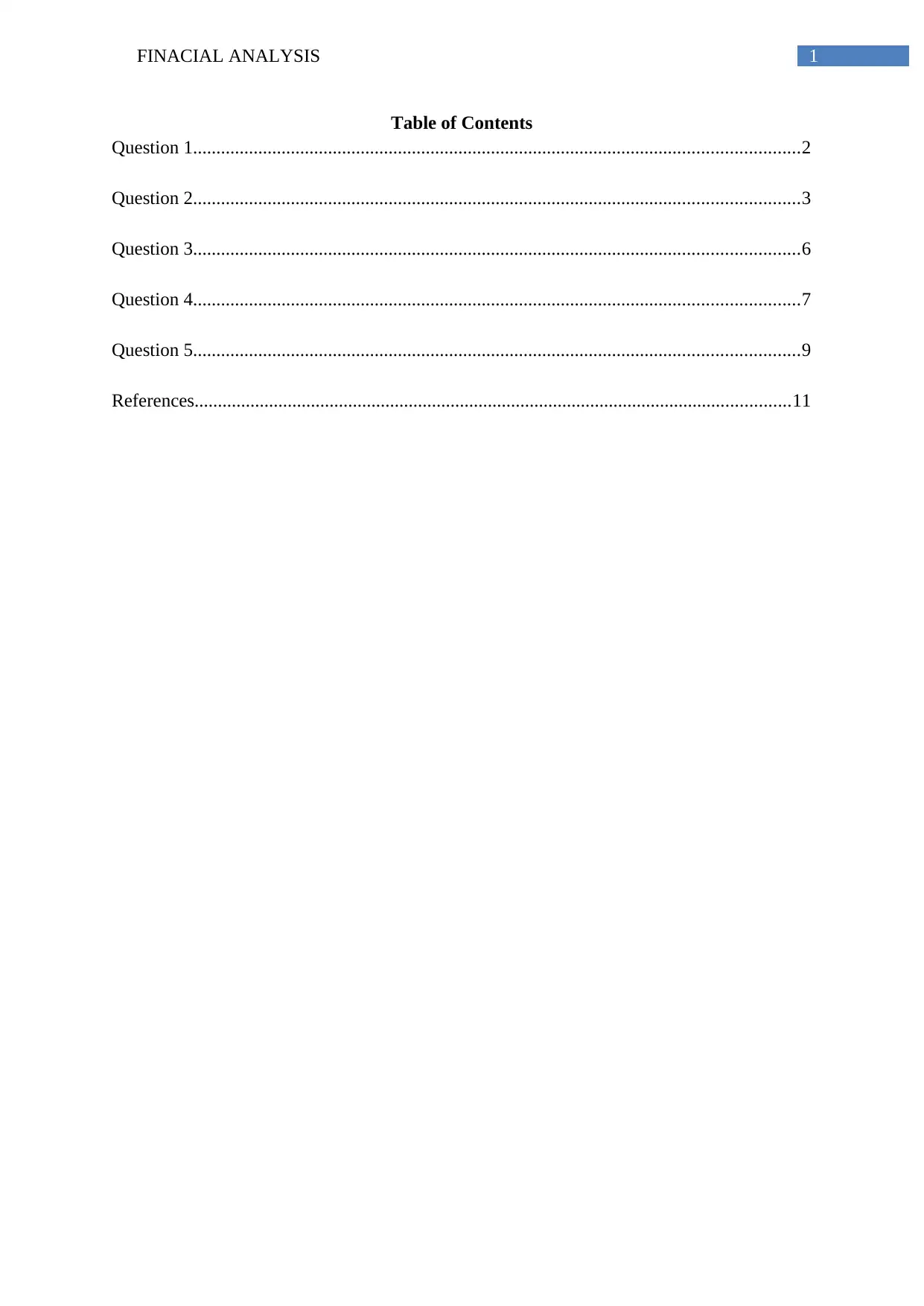
1FINACIAL ANALYSIS
Table of Contents
Question 1..................................................................................................................................2
Question 2..................................................................................................................................3
Question 3..................................................................................................................................6
Question 4..................................................................................................................................7
Question 5..................................................................................................................................9
References................................................................................................................................11
Table of Contents
Question 1..................................................................................................................................2
Question 2..................................................................................................................................3
Question 3..................................................................................................................................6
Question 4..................................................................................................................................7
Question 5..................................................................................................................................9
References................................................................................................................................11
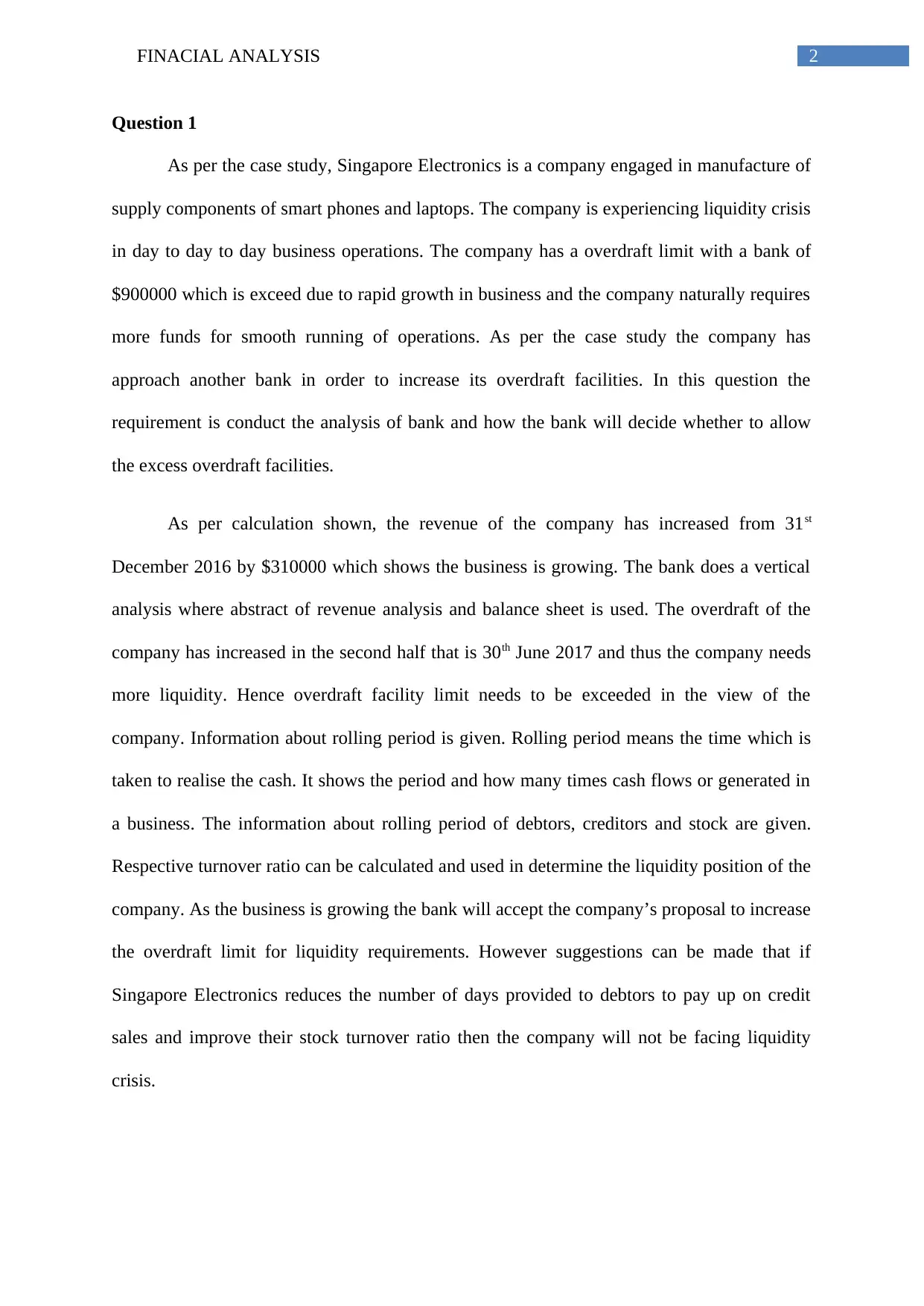
2FINACIAL ANALYSIS
Question 1
As per the case study, Singapore Electronics is a company engaged in manufacture of
supply components of smart phones and laptops. The company is experiencing liquidity crisis
in day to day to day business operations. The company has a overdraft limit with a bank of
$900000 which is exceed due to rapid growth in business and the company naturally requires
more funds for smooth running of operations. As per the case study the company has
approach another bank in order to increase its overdraft facilities. In this question the
requirement is conduct the analysis of bank and how the bank will decide whether to allow
the excess overdraft facilities.
As per calculation shown, the revenue of the company has increased from 31st
December 2016 by $310000 which shows the business is growing. The bank does a vertical
analysis where abstract of revenue analysis and balance sheet is used. The overdraft of the
company has increased in the second half that is 30th June 2017 and thus the company needs
more liquidity. Hence overdraft facility limit needs to be exceeded in the view of the
company. Information about rolling period is given. Rolling period means the time which is
taken to realise the cash. It shows the period and how many times cash flows or generated in
a business. The information about rolling period of debtors, creditors and stock are given.
Respective turnover ratio can be calculated and used in determine the liquidity position of the
company. As the business is growing the bank will accept the company’s proposal to increase
the overdraft limit for liquidity requirements. However suggestions can be made that if
Singapore Electronics reduces the number of days provided to debtors to pay up on credit
sales and improve their stock turnover ratio then the company will not be facing liquidity
crisis.
Question 1
As per the case study, Singapore Electronics is a company engaged in manufacture of
supply components of smart phones and laptops. The company is experiencing liquidity crisis
in day to day to day business operations. The company has a overdraft limit with a bank of
$900000 which is exceed due to rapid growth in business and the company naturally requires
more funds for smooth running of operations. As per the case study the company has
approach another bank in order to increase its overdraft facilities. In this question the
requirement is conduct the analysis of bank and how the bank will decide whether to allow
the excess overdraft facilities.
As per calculation shown, the revenue of the company has increased from 31st
December 2016 by $310000 which shows the business is growing. The bank does a vertical
analysis where abstract of revenue analysis and balance sheet is used. The overdraft of the
company has increased in the second half that is 30th June 2017 and thus the company needs
more liquidity. Hence overdraft facility limit needs to be exceeded in the view of the
company. Information about rolling period is given. Rolling period means the time which is
taken to realise the cash. It shows the period and how many times cash flows or generated in
a business. The information about rolling period of debtors, creditors and stock are given.
Respective turnover ratio can be calculated and used in determine the liquidity position of the
company. As the business is growing the bank will accept the company’s proposal to increase
the overdraft limit for liquidity requirements. However suggestions can be made that if
Singapore Electronics reduces the number of days provided to debtors to pay up on credit
sales and improve their stock turnover ratio then the company will not be facing liquidity
crisis.
⊘ This is a preview!⊘
Do you want full access?
Subscribe today to unlock all pages.

Trusted by 1+ million students worldwide
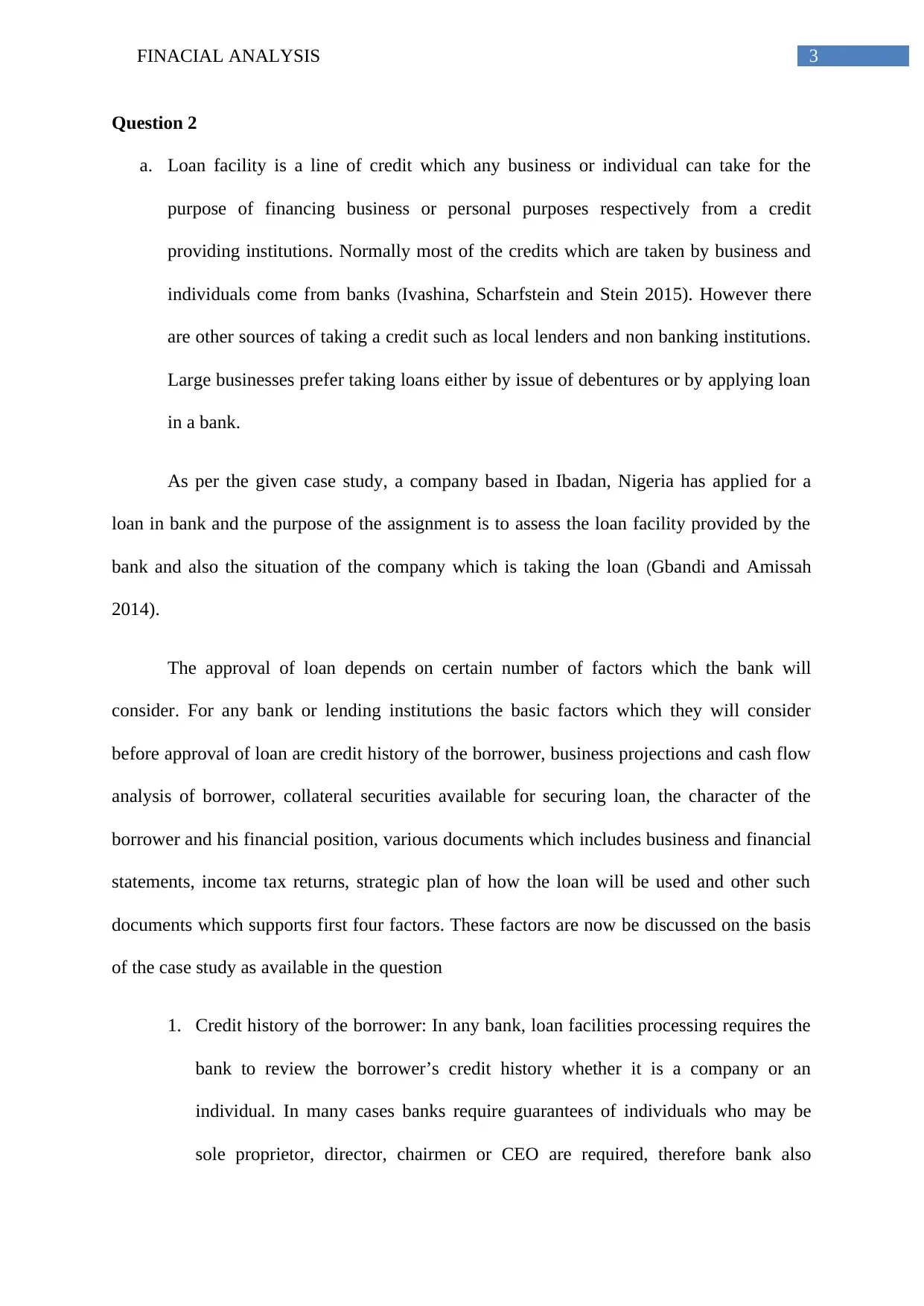
3FINACIAL ANALYSIS
Question 2
a. Loan facility is a line of credit which any business or individual can take for the
purpose of financing business or personal purposes respectively from a credit
providing institutions. Normally most of the credits which are taken by business and
individuals come from banks (Ivashina, Scharfstein and Stein 2015). However there
are other sources of taking a credit such as local lenders and non banking institutions.
Large businesses prefer taking loans either by issue of debentures or by applying loan
in a bank.
As per the given case study, a company based in Ibadan, Nigeria has applied for a
loan in bank and the purpose of the assignment is to assess the loan facility provided by the
bank and also the situation of the company which is taking the loan (Gbandi and Amissah
2014).
The approval of loan depends on certain number of factors which the bank will
consider. For any bank or lending institutions the basic factors which they will consider
before approval of loan are credit history of the borrower, business projections and cash flow
analysis of borrower, collateral securities available for securing loan, the character of the
borrower and his financial position, various documents which includes business and financial
statements, income tax returns, strategic plan of how the loan will be used and other such
documents which supports first four factors. These factors are now be discussed on the basis
of the case study as available in the question
1. Credit history of the borrower: In any bank, loan facilities processing requires the
bank to review the borrower’s credit history whether it is a company or an
individual. In many cases banks require guarantees of individuals who may be
sole proprietor, director, chairmen or CEO are required, therefore bank also
Question 2
a. Loan facility is a line of credit which any business or individual can take for the
purpose of financing business or personal purposes respectively from a credit
providing institutions. Normally most of the credits which are taken by business and
individuals come from banks (Ivashina, Scharfstein and Stein 2015). However there
are other sources of taking a credit such as local lenders and non banking institutions.
Large businesses prefer taking loans either by issue of debentures or by applying loan
in a bank.
As per the given case study, a company based in Ibadan, Nigeria has applied for a
loan in bank and the purpose of the assignment is to assess the loan facility provided by the
bank and also the situation of the company which is taking the loan (Gbandi and Amissah
2014).
The approval of loan depends on certain number of factors which the bank will
consider. For any bank or lending institutions the basic factors which they will consider
before approval of loan are credit history of the borrower, business projections and cash flow
analysis of borrower, collateral securities available for securing loan, the character of the
borrower and his financial position, various documents which includes business and financial
statements, income tax returns, strategic plan of how the loan will be used and other such
documents which supports first four factors. These factors are now be discussed on the basis
of the case study as available in the question
1. Credit history of the borrower: In any bank, loan facilities processing requires the
bank to review the borrower’s credit history whether it is a company or an
individual. In many cases banks require guarantees of individuals who may be
sole proprietor, director, chairmen or CEO are required, therefore bank also
Paraphrase This Document
Need a fresh take? Get an instant paraphrase of this document with our AI Paraphraser
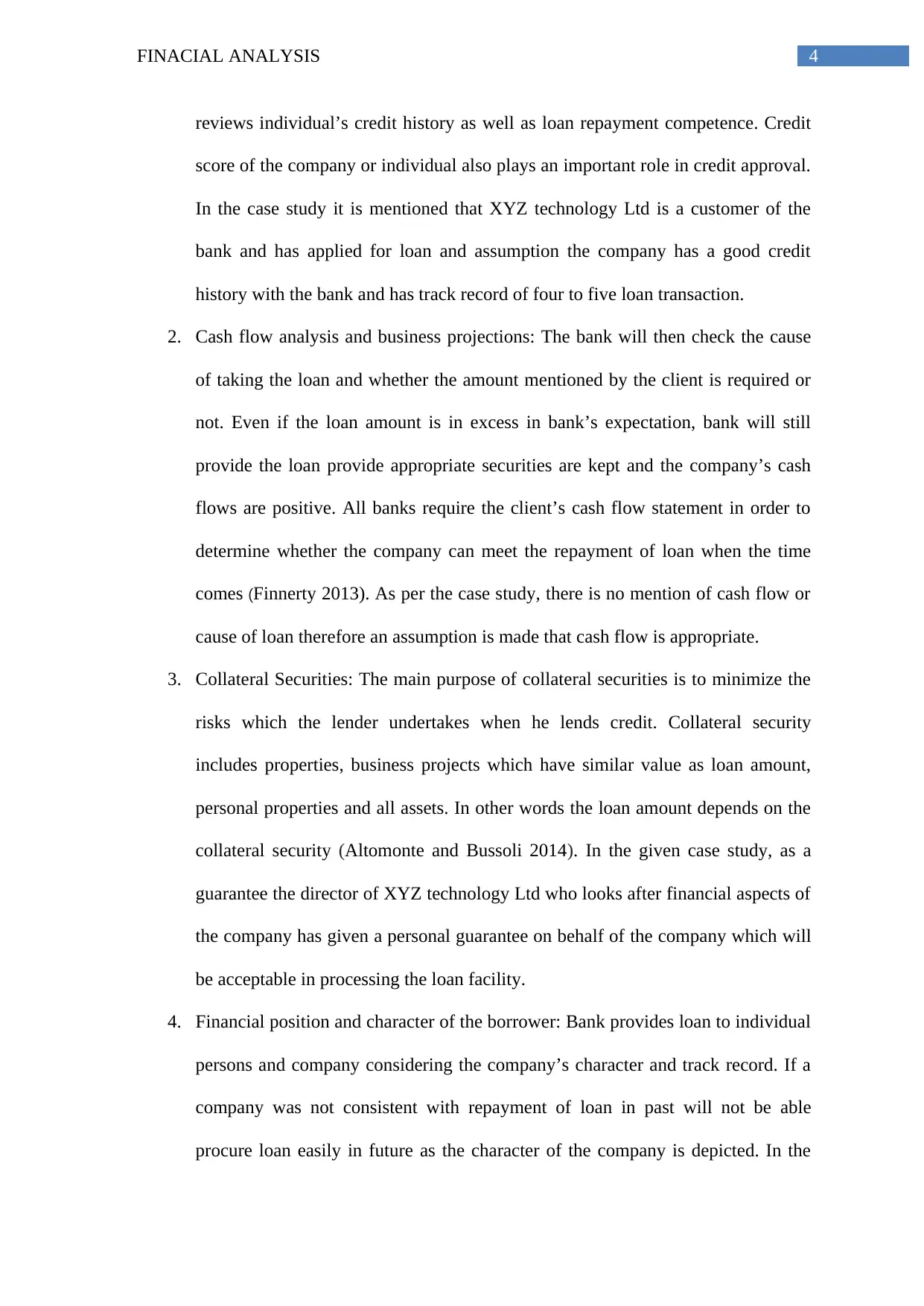
4FINACIAL ANALYSIS
reviews individual’s credit history as well as loan repayment competence. Credit
score of the company or individual also plays an important role in credit approval.
In the case study it is mentioned that XYZ technology Ltd is a customer of the
bank and has applied for loan and assumption the company has a good credit
history with the bank and has track record of four to five loan transaction.
2. Cash flow analysis and business projections: The bank will then check the cause
of taking the loan and whether the amount mentioned by the client is required or
not. Even if the loan amount is in excess in bank’s expectation, bank will still
provide the loan provide appropriate securities are kept and the company’s cash
flows are positive. All banks require the client’s cash flow statement in order to
determine whether the company can meet the repayment of loan when the time
comes (Finnerty 2013). As per the case study, there is no mention of cash flow or
cause of loan therefore an assumption is made that cash flow is appropriate.
3. Collateral Securities: The main purpose of collateral securities is to minimize the
risks which the lender undertakes when he lends credit. Collateral security
includes properties, business projects which have similar value as loan amount,
personal properties and all assets. In other words the loan amount depends on the
collateral security (Altomonte and Bussoli 2014). In the given case study, as a
guarantee the director of XYZ technology Ltd who looks after financial aspects of
the company has given a personal guarantee on behalf of the company which will
be acceptable in processing the loan facility.
4. Financial position and character of the borrower: Bank provides loan to individual
persons and company considering the company’s character and track record. If a
company was not consistent with repayment of loan in past will not be able
procure loan easily in future as the character of the company is depicted. In the
reviews individual’s credit history as well as loan repayment competence. Credit
score of the company or individual also plays an important role in credit approval.
In the case study it is mentioned that XYZ technology Ltd is a customer of the
bank and has applied for loan and assumption the company has a good credit
history with the bank and has track record of four to five loan transaction.
2. Cash flow analysis and business projections: The bank will then check the cause
of taking the loan and whether the amount mentioned by the client is required or
not. Even if the loan amount is in excess in bank’s expectation, bank will still
provide the loan provide appropriate securities are kept and the company’s cash
flows are positive. All banks require the client’s cash flow statement in order to
determine whether the company can meet the repayment of loan when the time
comes (Finnerty 2013). As per the case study, there is no mention of cash flow or
cause of loan therefore an assumption is made that cash flow is appropriate.
3. Collateral Securities: The main purpose of collateral securities is to minimize the
risks which the lender undertakes when he lends credit. Collateral security
includes properties, business projects which have similar value as loan amount,
personal properties and all assets. In other words the loan amount depends on the
collateral security (Altomonte and Bussoli 2014). In the given case study, as a
guarantee the director of XYZ technology Ltd who looks after financial aspects of
the company has given a personal guarantee on behalf of the company which will
be acceptable in processing the loan facility.
4. Financial position and character of the borrower: Bank provides loan to individual
persons and company considering the company’s character and track record. If a
company was not consistent with repayment of loan in past will not be able
procure loan easily in future as the character of the company is depicted. In the
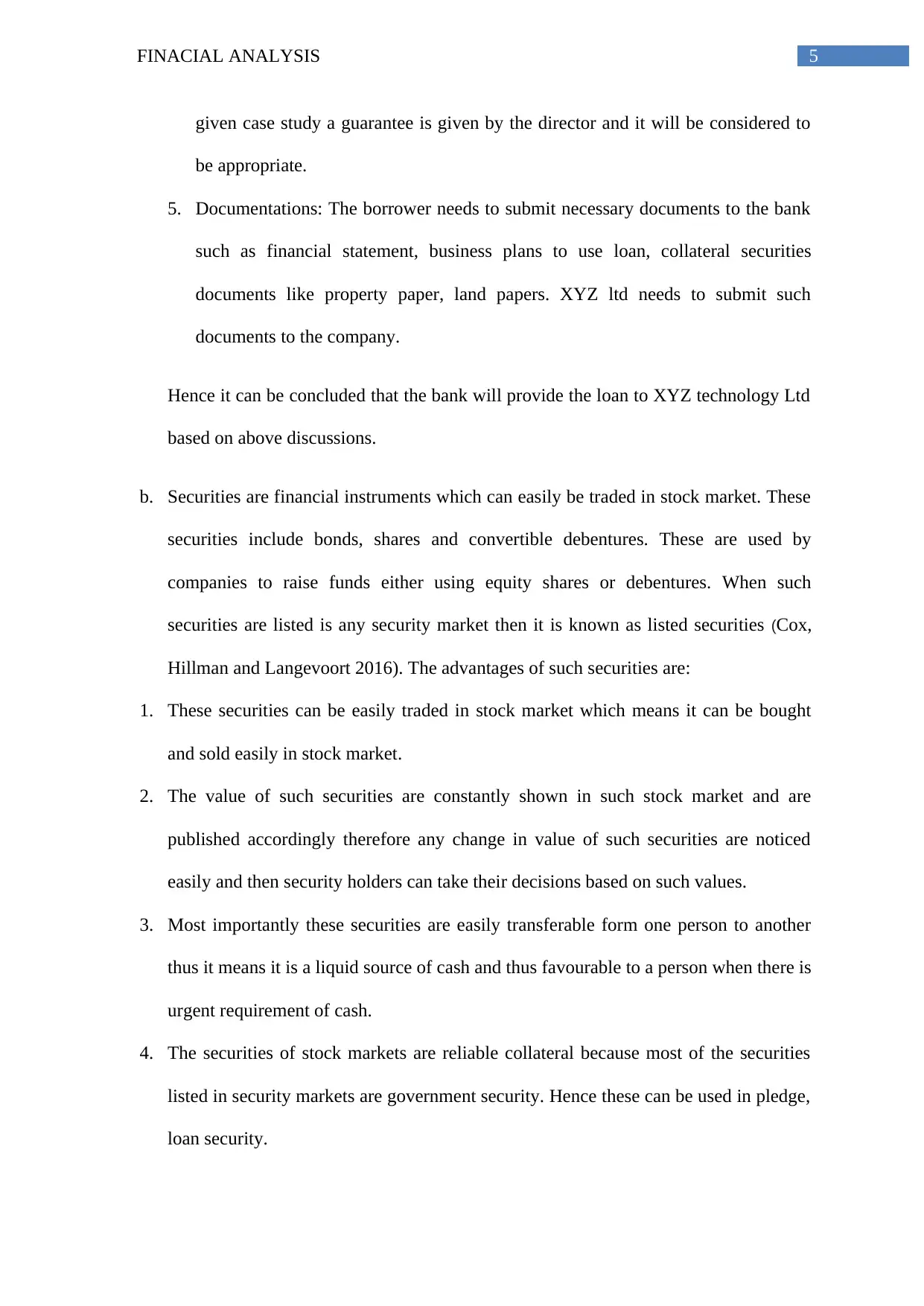
5FINACIAL ANALYSIS
given case study a guarantee is given by the director and it will be considered to
be appropriate.
5. Documentations: The borrower needs to submit necessary documents to the bank
such as financial statement, business plans to use loan, collateral securities
documents like property paper, land papers. XYZ ltd needs to submit such
documents to the company.
Hence it can be concluded that the bank will provide the loan to XYZ technology Ltd
based on above discussions.
b. Securities are financial instruments which can easily be traded in stock market. These
securities include bonds, shares and convertible debentures. These are used by
companies to raise funds either using equity shares or debentures. When such
securities are listed is any security market then it is known as listed securities (Cox,
Hillman and Langevoort 2016). The advantages of such securities are:
1. These securities can be easily traded in stock market which means it can be bought
and sold easily in stock market.
2. The value of such securities are constantly shown in such stock market and are
published accordingly therefore any change in value of such securities are noticed
easily and then security holders can take their decisions based on such values.
3. Most importantly these securities are easily transferable form one person to another
thus it means it is a liquid source of cash and thus favourable to a person when there is
urgent requirement of cash.
4. The securities of stock markets are reliable collateral because most of the securities
listed in security markets are government security. Hence these can be used in pledge,
loan security.
given case study a guarantee is given by the director and it will be considered to
be appropriate.
5. Documentations: The borrower needs to submit necessary documents to the bank
such as financial statement, business plans to use loan, collateral securities
documents like property paper, land papers. XYZ ltd needs to submit such
documents to the company.
Hence it can be concluded that the bank will provide the loan to XYZ technology Ltd
based on above discussions.
b. Securities are financial instruments which can easily be traded in stock market. These
securities include bonds, shares and convertible debentures. These are used by
companies to raise funds either using equity shares or debentures. When such
securities are listed is any security market then it is known as listed securities (Cox,
Hillman and Langevoort 2016). The advantages of such securities are:
1. These securities can be easily traded in stock market which means it can be bought
and sold easily in stock market.
2. The value of such securities are constantly shown in such stock market and are
published accordingly therefore any change in value of such securities are noticed
easily and then security holders can take their decisions based on such values.
3. Most importantly these securities are easily transferable form one person to another
thus it means it is a liquid source of cash and thus favourable to a person when there is
urgent requirement of cash.
4. The securities of stock markets are reliable collateral because most of the securities
listed in security markets are government security. Hence these can be used in pledge,
loan security.
⊘ This is a preview!⊘
Do you want full access?
Subscribe today to unlock all pages.

Trusted by 1+ million students worldwide
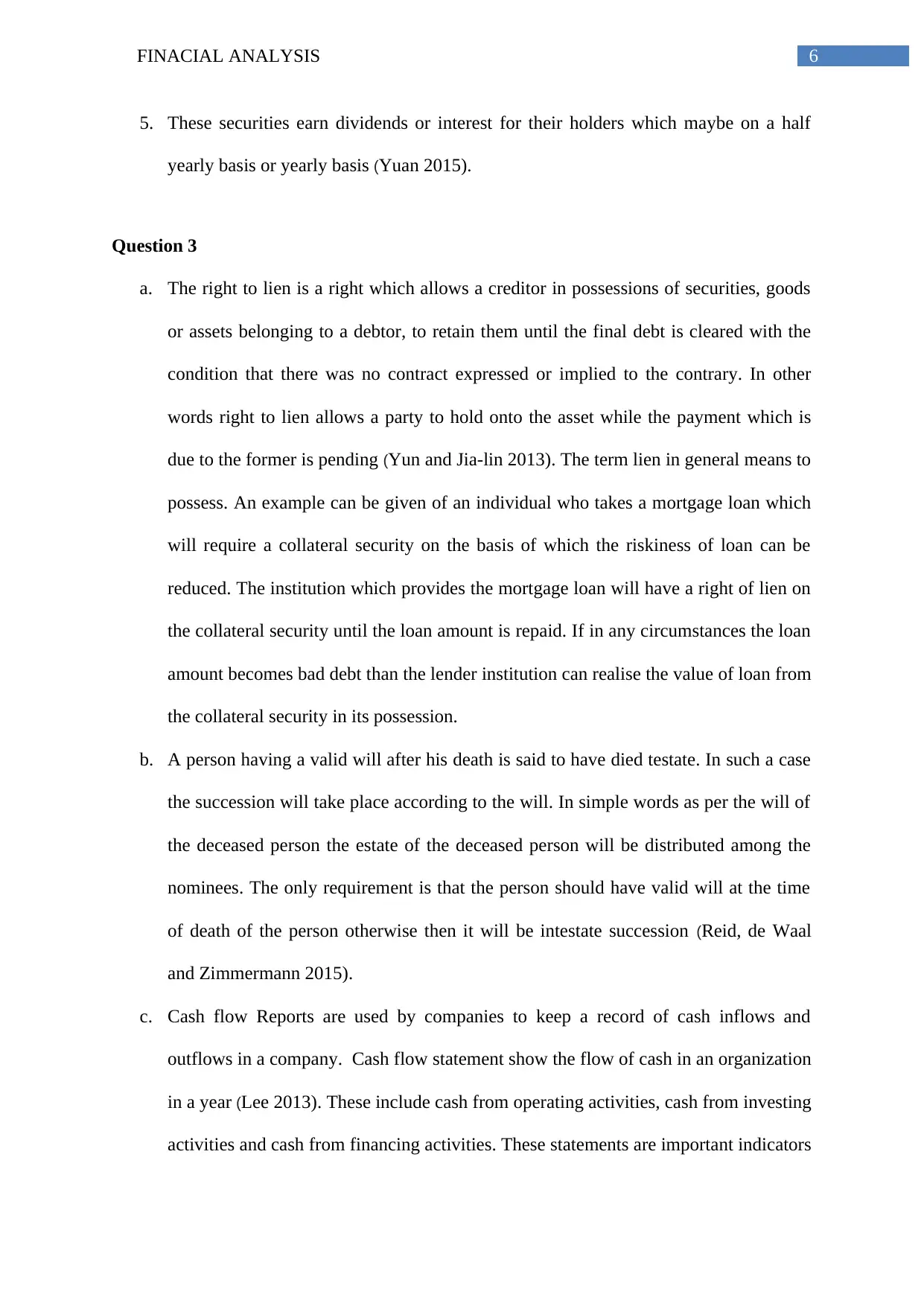
6FINACIAL ANALYSIS
5. These securities earn dividends or interest for their holders which maybe on a half
yearly basis or yearly basis (Yuan 2015).
Question 3
a. The right to lien is a right which allows a creditor in possessions of securities, goods
or assets belonging to a debtor, to retain them until the final debt is cleared with the
condition that there was no contract expressed or implied to the contrary. In other
words right to lien allows a party to hold onto the asset while the payment which is
due to the former is pending (Yun and Jia-lin 2013). The term lien in general means to
possess. An example can be given of an individual who takes a mortgage loan which
will require a collateral security on the basis of which the riskiness of loan can be
reduced. The institution which provides the mortgage loan will have a right of lien on
the collateral security until the loan amount is repaid. If in any circumstances the loan
amount becomes bad debt than the lender institution can realise the value of loan from
the collateral security in its possession.
b. A person having a valid will after his death is said to have died testate. In such a case
the succession will take place according to the will. In simple words as per the will of
the deceased person the estate of the deceased person will be distributed among the
nominees. The only requirement is that the person should have valid will at the time
of death of the person otherwise then it will be intestate succession (Reid, de Waal
and Zimmermann 2015).
c. Cash flow Reports are used by companies to keep a record of cash inflows and
outflows in a company. Cash flow statement show the flow of cash in an organization
in a year (Lee 2013). These include cash from operating activities, cash from investing
activities and cash from financing activities. These statements are important indicators
5. These securities earn dividends or interest for their holders which maybe on a half
yearly basis or yearly basis (Yuan 2015).
Question 3
a. The right to lien is a right which allows a creditor in possessions of securities, goods
or assets belonging to a debtor, to retain them until the final debt is cleared with the
condition that there was no contract expressed or implied to the contrary. In other
words right to lien allows a party to hold onto the asset while the payment which is
due to the former is pending (Yun and Jia-lin 2013). The term lien in general means to
possess. An example can be given of an individual who takes a mortgage loan which
will require a collateral security on the basis of which the riskiness of loan can be
reduced. The institution which provides the mortgage loan will have a right of lien on
the collateral security until the loan amount is repaid. If in any circumstances the loan
amount becomes bad debt than the lender institution can realise the value of loan from
the collateral security in its possession.
b. A person having a valid will after his death is said to have died testate. In such a case
the succession will take place according to the will. In simple words as per the will of
the deceased person the estate of the deceased person will be distributed among the
nominees. The only requirement is that the person should have valid will at the time
of death of the person otherwise then it will be intestate succession (Reid, de Waal
and Zimmermann 2015).
c. Cash flow Reports are used by companies to keep a record of cash inflows and
outflows in a company. Cash flow statement show the flow of cash in an organization
in a year (Lee 2013). These include cash from operating activities, cash from investing
activities and cash from financing activities. These statements are important indicators
Paraphrase This Document
Need a fresh take? Get an instant paraphrase of this document with our AI Paraphraser
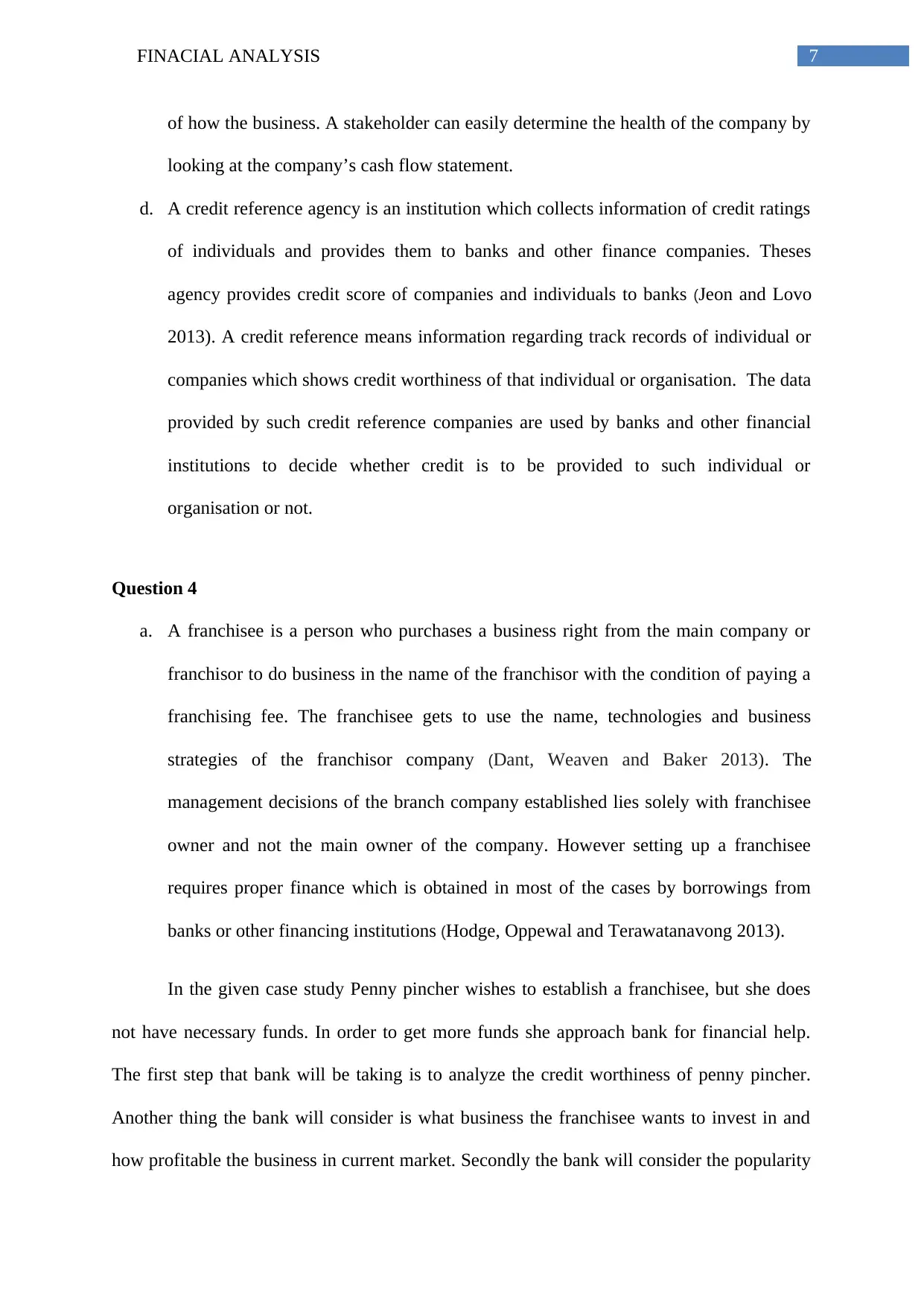
7FINACIAL ANALYSIS
of how the business. A stakeholder can easily determine the health of the company by
looking at the company’s cash flow statement.
d. A credit reference agency is an institution which collects information of credit ratings
of individuals and provides them to banks and other finance companies. Theses
agency provides credit score of companies and individuals to banks (Jeon and Lovo
2013). A credit reference means information regarding track records of individual or
companies which shows credit worthiness of that individual or organisation. The data
provided by such credit reference companies are used by banks and other financial
institutions to decide whether credit is to be provided to such individual or
organisation or not.
Question 4
a. A franchisee is a person who purchases a business right from the main company or
franchisor to do business in the name of the franchisor with the condition of paying a
franchising fee. The franchisee gets to use the name, technologies and business
strategies of the franchisor company (Dant, Weaven and Baker 2013). The
management decisions of the branch company established lies solely with franchisee
owner and not the main owner of the company. However setting up a franchisee
requires proper finance which is obtained in most of the cases by borrowings from
banks or other financing institutions (Hodge, Oppewal and Terawatanavong 2013).
In the given case study Penny pincher wishes to establish a franchisee, but she does
not have necessary funds. In order to get more funds she approach bank for financial help.
The first step that bank will be taking is to analyze the credit worthiness of penny pincher.
Another thing the bank will consider is what business the franchisee wants to invest in and
how profitable the business in current market. Secondly the bank will consider the popularity
of how the business. A stakeholder can easily determine the health of the company by
looking at the company’s cash flow statement.
d. A credit reference agency is an institution which collects information of credit ratings
of individuals and provides them to banks and other finance companies. Theses
agency provides credit score of companies and individuals to banks (Jeon and Lovo
2013). A credit reference means information regarding track records of individual or
companies which shows credit worthiness of that individual or organisation. The data
provided by such credit reference companies are used by banks and other financial
institutions to decide whether credit is to be provided to such individual or
organisation or not.
Question 4
a. A franchisee is a person who purchases a business right from the main company or
franchisor to do business in the name of the franchisor with the condition of paying a
franchising fee. The franchisee gets to use the name, technologies and business
strategies of the franchisor company (Dant, Weaven and Baker 2013). The
management decisions of the branch company established lies solely with franchisee
owner and not the main owner of the company. However setting up a franchisee
requires proper finance which is obtained in most of the cases by borrowings from
banks or other financing institutions (Hodge, Oppewal and Terawatanavong 2013).
In the given case study Penny pincher wishes to establish a franchisee, but she does
not have necessary funds. In order to get more funds she approach bank for financial help.
The first step that bank will be taking is to analyze the credit worthiness of penny pincher.
Another thing the bank will consider is what business the franchisee wants to invest in and
how profitable the business in current market. Secondly the bank will consider the popularity
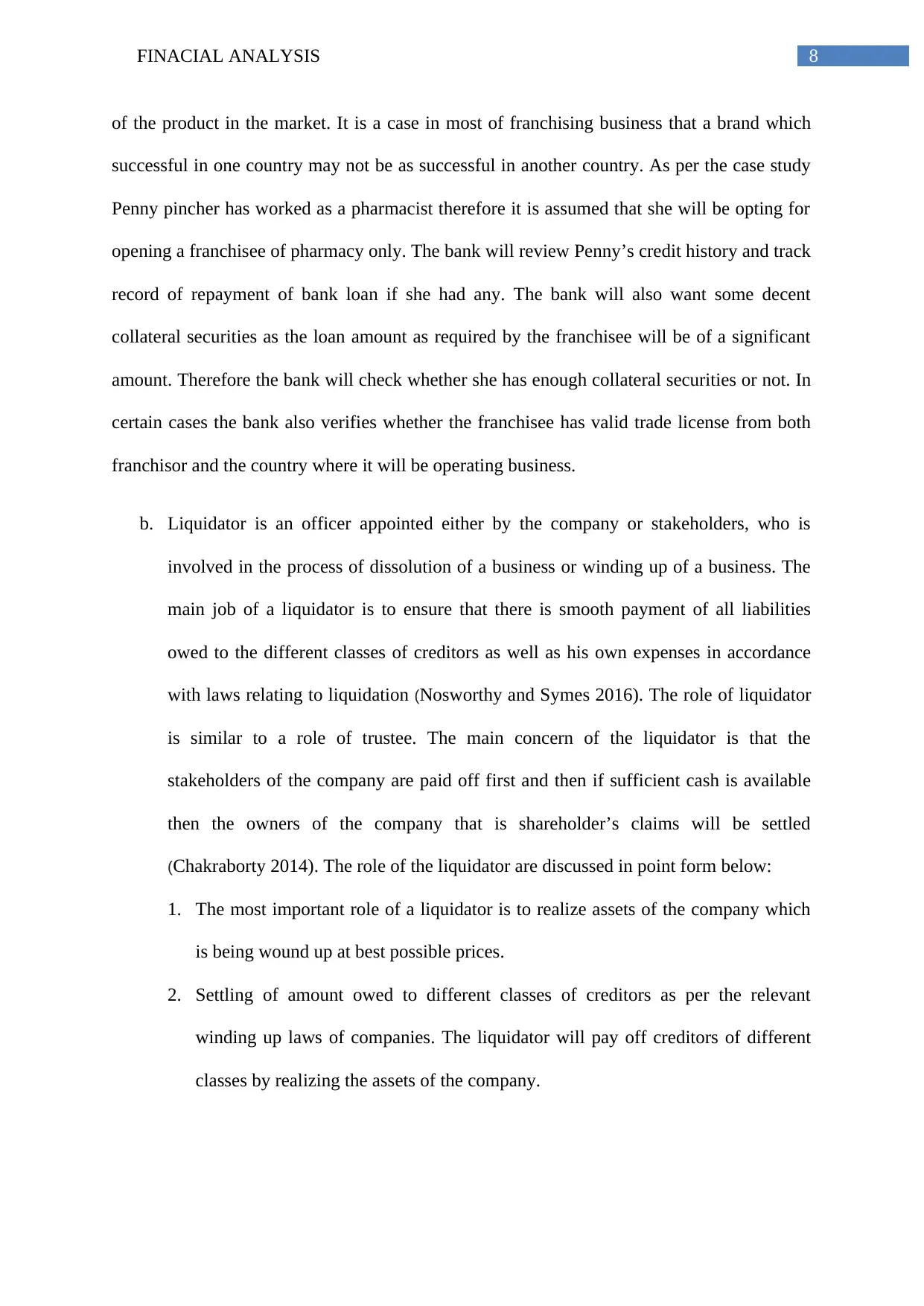
8FINACIAL ANALYSIS
of the product in the market. It is a case in most of franchising business that a brand which
successful in one country may not be as successful in another country. As per the case study
Penny pincher has worked as a pharmacist therefore it is assumed that she will be opting for
opening a franchisee of pharmacy only. The bank will review Penny’s credit history and track
record of repayment of bank loan if she had any. The bank will also want some decent
collateral securities as the loan amount as required by the franchisee will be of a significant
amount. Therefore the bank will check whether she has enough collateral securities or not. In
certain cases the bank also verifies whether the franchisee has valid trade license from both
franchisor and the country where it will be operating business.
b. Liquidator is an officer appointed either by the company or stakeholders, who is
involved in the process of dissolution of a business or winding up of a business. The
main job of a liquidator is to ensure that there is smooth payment of all liabilities
owed to the different classes of creditors as well as his own expenses in accordance
with laws relating to liquidation (Nosworthy and Symes 2016). The role of liquidator
is similar to a role of trustee. The main concern of the liquidator is that the
stakeholders of the company are paid off first and then if sufficient cash is available
then the owners of the company that is shareholder’s claims will be settled
(Chakraborty 2014). The role of the liquidator are discussed in point form below:
1. The most important role of a liquidator is to realize assets of the company which
is being wound up at best possible prices.
2. Settling of amount owed to different classes of creditors as per the relevant
winding up laws of companies. The liquidator will pay off creditors of different
classes by realizing the assets of the company.
of the product in the market. It is a case in most of franchising business that a brand which
successful in one country may not be as successful in another country. As per the case study
Penny pincher has worked as a pharmacist therefore it is assumed that she will be opting for
opening a franchisee of pharmacy only. The bank will review Penny’s credit history and track
record of repayment of bank loan if she had any. The bank will also want some decent
collateral securities as the loan amount as required by the franchisee will be of a significant
amount. Therefore the bank will check whether she has enough collateral securities or not. In
certain cases the bank also verifies whether the franchisee has valid trade license from both
franchisor and the country where it will be operating business.
b. Liquidator is an officer appointed either by the company or stakeholders, who is
involved in the process of dissolution of a business or winding up of a business. The
main job of a liquidator is to ensure that there is smooth payment of all liabilities
owed to the different classes of creditors as well as his own expenses in accordance
with laws relating to liquidation (Nosworthy and Symes 2016). The role of liquidator
is similar to a role of trustee. The main concern of the liquidator is that the
stakeholders of the company are paid off first and then if sufficient cash is available
then the owners of the company that is shareholder’s claims will be settled
(Chakraborty 2014). The role of the liquidator are discussed in point form below:
1. The most important role of a liquidator is to realize assets of the company which
is being wound up at best possible prices.
2. Settling of amount owed to different classes of creditors as per the relevant
winding up laws of companies. The liquidator will pay off creditors of different
classes by realizing the assets of the company.
⊘ This is a preview!⊘
Do you want full access?
Subscribe today to unlock all pages.

Trusted by 1+ million students worldwide
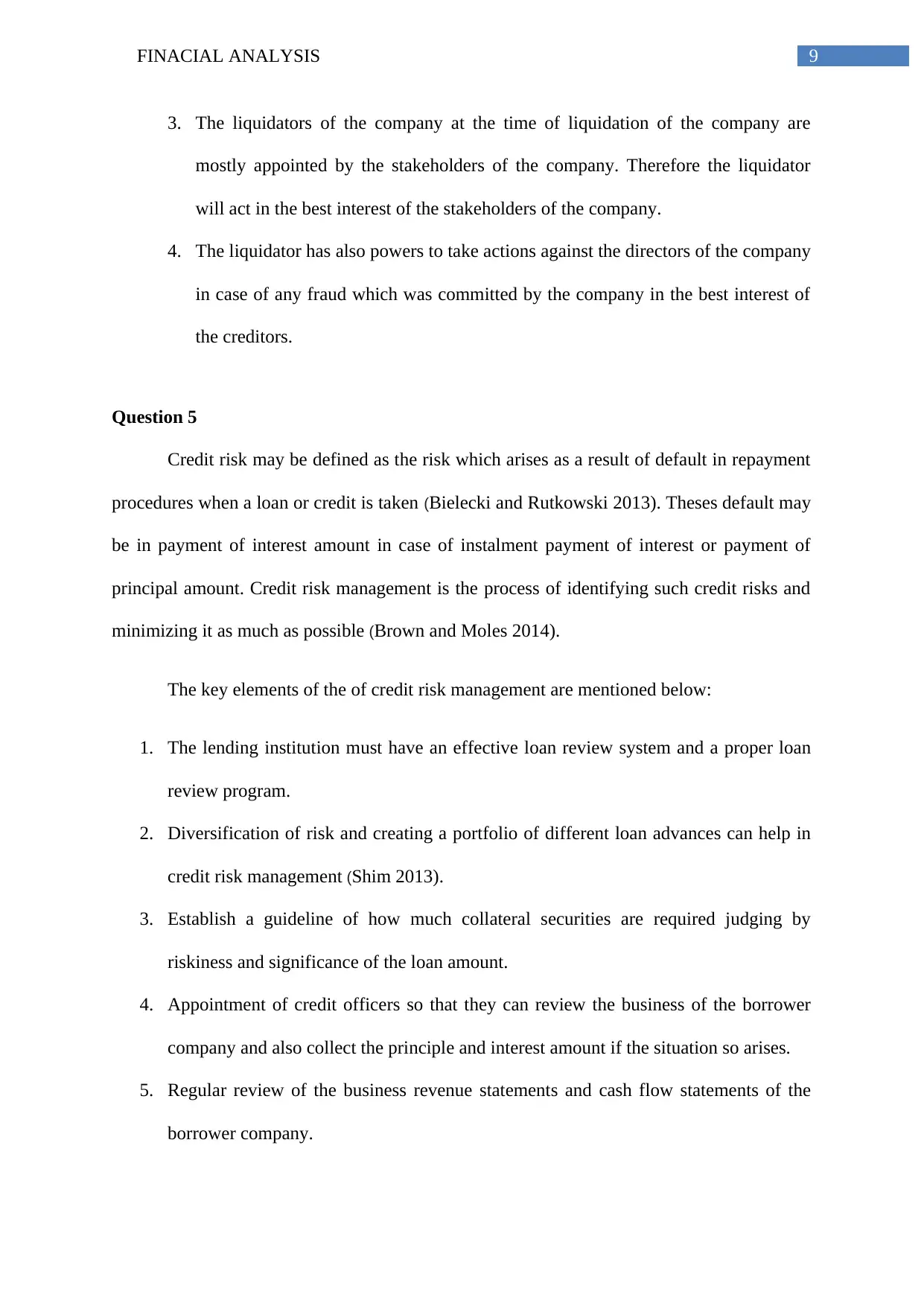
9FINACIAL ANALYSIS
3. The liquidators of the company at the time of liquidation of the company are
mostly appointed by the stakeholders of the company. Therefore the liquidator
will act in the best interest of the stakeholders of the company.
4. The liquidator has also powers to take actions against the directors of the company
in case of any fraud which was committed by the company in the best interest of
the creditors.
Question 5
Credit risk may be defined as the risk which arises as a result of default in repayment
procedures when a loan or credit is taken (Bielecki and Rutkowski 2013). Theses default may
be in payment of interest amount in case of instalment payment of interest or payment of
principal amount. Credit risk management is the process of identifying such credit risks and
minimizing it as much as possible (Brown and Moles 2014).
The key elements of the of credit risk management are mentioned below:
1. The lending institution must have an effective loan review system and a proper loan
review program.
2. Diversification of risk and creating a portfolio of different loan advances can help in
credit risk management (Shim 2013).
3. Establish a guideline of how much collateral securities are required judging by
riskiness and significance of the loan amount.
4. Appointment of credit officers so that they can review the business of the borrower
company and also collect the principle and interest amount if the situation so arises.
5. Regular review of the business revenue statements and cash flow statements of the
borrower company.
3. The liquidators of the company at the time of liquidation of the company are
mostly appointed by the stakeholders of the company. Therefore the liquidator
will act in the best interest of the stakeholders of the company.
4. The liquidator has also powers to take actions against the directors of the company
in case of any fraud which was committed by the company in the best interest of
the creditors.
Question 5
Credit risk may be defined as the risk which arises as a result of default in repayment
procedures when a loan or credit is taken (Bielecki and Rutkowski 2013). Theses default may
be in payment of interest amount in case of instalment payment of interest or payment of
principal amount. Credit risk management is the process of identifying such credit risks and
minimizing it as much as possible (Brown and Moles 2014).
The key elements of the of credit risk management are mentioned below:
1. The lending institution must have an effective loan review system and a proper loan
review program.
2. Diversification of risk and creating a portfolio of different loan advances can help in
credit risk management (Shim 2013).
3. Establish a guideline of how much collateral securities are required judging by
riskiness and significance of the loan amount.
4. Appointment of credit officers so that they can review the business of the borrower
company and also collect the principle and interest amount if the situation so arises.
5. Regular review of the business revenue statements and cash flow statements of the
borrower company.
Paraphrase This Document
Need a fresh take? Get an instant paraphrase of this document with our AI Paraphraser
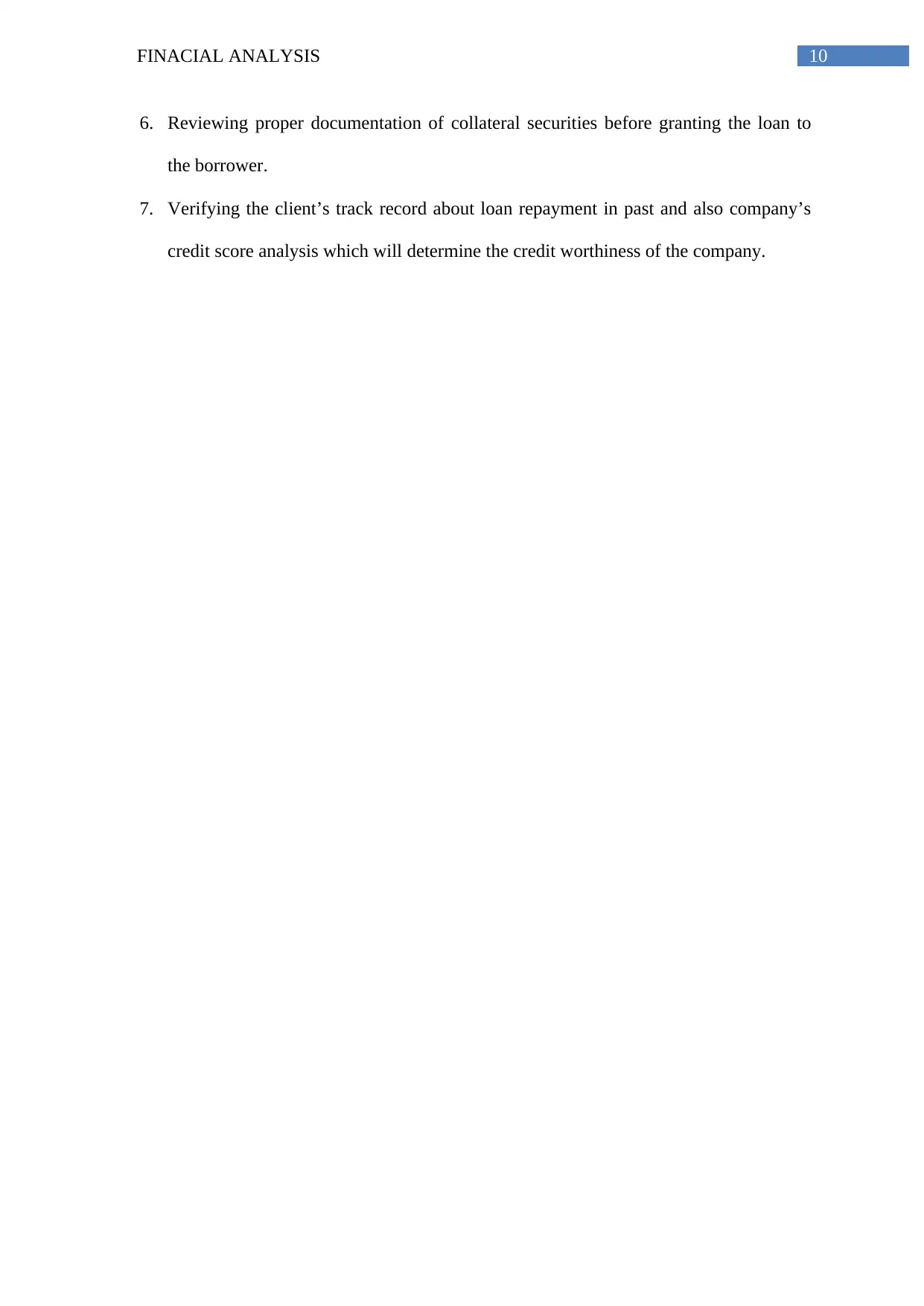
10FINACIAL ANALYSIS
6. Reviewing proper documentation of collateral securities before granting the loan to
the borrower.
7. Verifying the client’s track record about loan repayment in past and also company’s
credit score analysis which will determine the credit worthiness of the company.
6. Reviewing proper documentation of collateral securities before granting the loan to
the borrower.
7. Verifying the client’s track record about loan repayment in past and also company’s
credit score analysis which will determine the credit worthiness of the company.
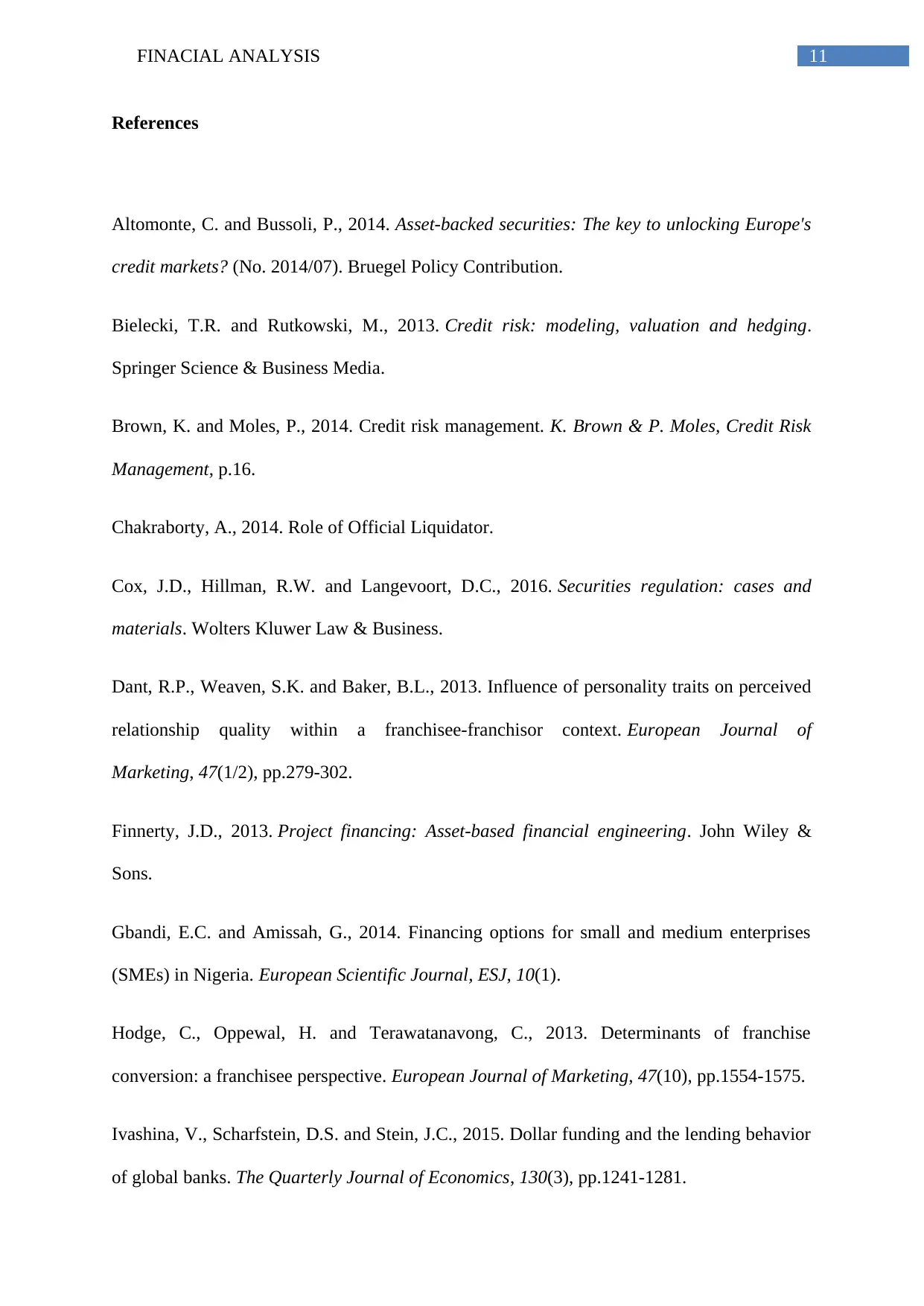
11FINACIAL ANALYSIS
References
Altomonte, C. and Bussoli, P., 2014. Asset-backed securities: The key to unlocking Europe's
credit markets? (No. 2014/07). Bruegel Policy Contribution.
Bielecki, T.R. and Rutkowski, M., 2013. Credit risk: modeling, valuation and hedging.
Springer Science & Business Media.
Brown, K. and Moles, P., 2014. Credit risk management. K. Brown & P. Moles, Credit Risk
Management, p.16.
Chakraborty, A., 2014. Role of Official Liquidator.
Cox, J.D., Hillman, R.W. and Langevoort, D.C., 2016. Securities regulation: cases and
materials. Wolters Kluwer Law & Business.
Dant, R.P., Weaven, S.K. and Baker, B.L., 2013. Influence of personality traits on perceived
relationship quality within a franchisee-franchisor context. European Journal of
Marketing, 47(1/2), pp.279-302.
Finnerty, J.D., 2013. Project financing: Asset-based financial engineering. John Wiley &
Sons.
Gbandi, E.C. and Amissah, G., 2014. Financing options for small and medium enterprises
(SMEs) in Nigeria. European Scientific Journal, ESJ, 10(1).
Hodge, C., Oppewal, H. and Terawatanavong, C., 2013. Determinants of franchise
conversion: a franchisee perspective. European Journal of Marketing, 47(10), pp.1554-1575.
Ivashina, V., Scharfstein, D.S. and Stein, J.C., 2015. Dollar funding and the lending behavior
of global banks. The Quarterly Journal of Economics, 130(3), pp.1241-1281.
References
Altomonte, C. and Bussoli, P., 2014. Asset-backed securities: The key to unlocking Europe's
credit markets? (No. 2014/07). Bruegel Policy Contribution.
Bielecki, T.R. and Rutkowski, M., 2013. Credit risk: modeling, valuation and hedging.
Springer Science & Business Media.
Brown, K. and Moles, P., 2014. Credit risk management. K. Brown & P. Moles, Credit Risk
Management, p.16.
Chakraborty, A., 2014. Role of Official Liquidator.
Cox, J.D., Hillman, R.W. and Langevoort, D.C., 2016. Securities regulation: cases and
materials. Wolters Kluwer Law & Business.
Dant, R.P., Weaven, S.K. and Baker, B.L., 2013. Influence of personality traits on perceived
relationship quality within a franchisee-franchisor context. European Journal of
Marketing, 47(1/2), pp.279-302.
Finnerty, J.D., 2013. Project financing: Asset-based financial engineering. John Wiley &
Sons.
Gbandi, E.C. and Amissah, G., 2014. Financing options for small and medium enterprises
(SMEs) in Nigeria. European Scientific Journal, ESJ, 10(1).
Hodge, C., Oppewal, H. and Terawatanavong, C., 2013. Determinants of franchise
conversion: a franchisee perspective. European Journal of Marketing, 47(10), pp.1554-1575.
Ivashina, V., Scharfstein, D.S. and Stein, J.C., 2015. Dollar funding and the lending behavior
of global banks. The Quarterly Journal of Economics, 130(3), pp.1241-1281.
⊘ This is a preview!⊘
Do you want full access?
Subscribe today to unlock all pages.

Trusted by 1+ million students worldwide
1 out of 13
Related Documents
Your All-in-One AI-Powered Toolkit for Academic Success.
+13062052269
info@desklib.com
Available 24*7 on WhatsApp / Email
![[object Object]](/_next/static/media/star-bottom.7253800d.svg)
Unlock your academic potential
Copyright © 2020–2025 A2Z Services. All Rights Reserved. Developed and managed by ZUCOL.



